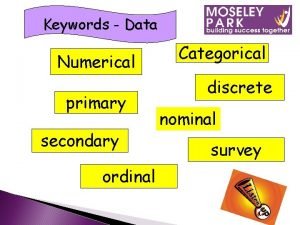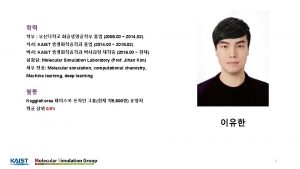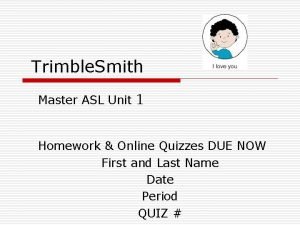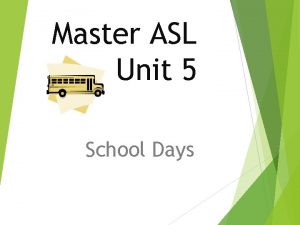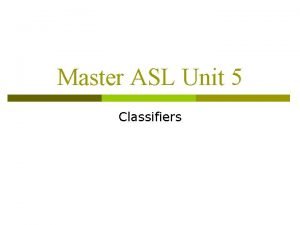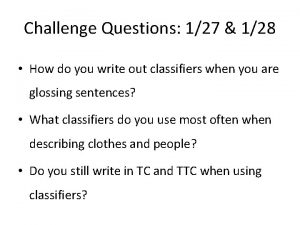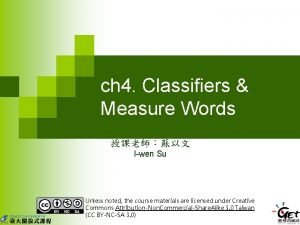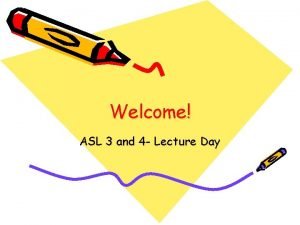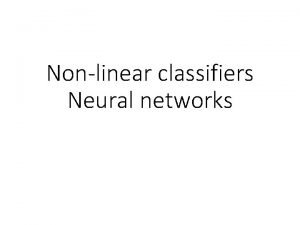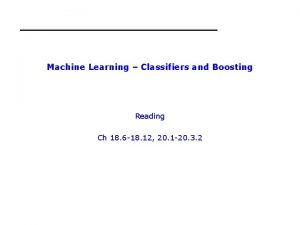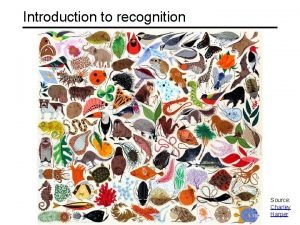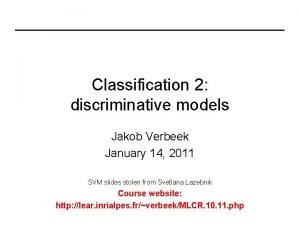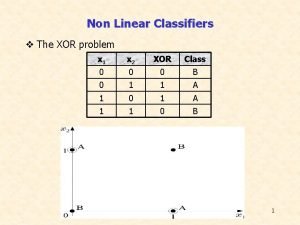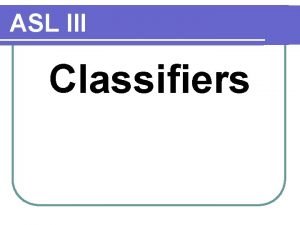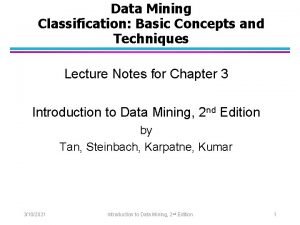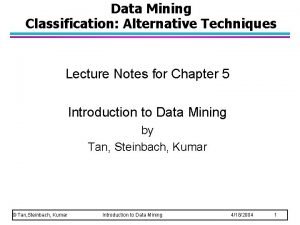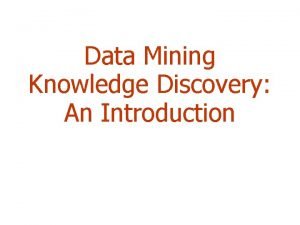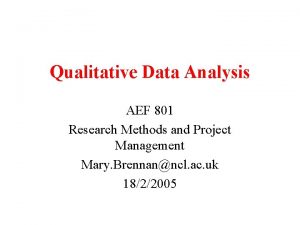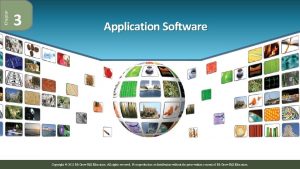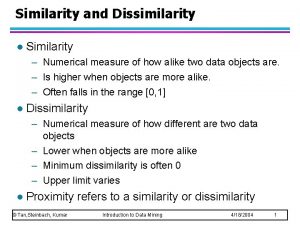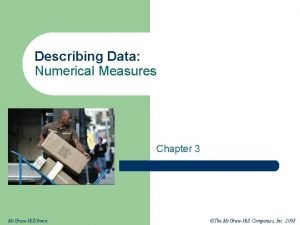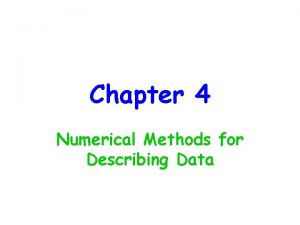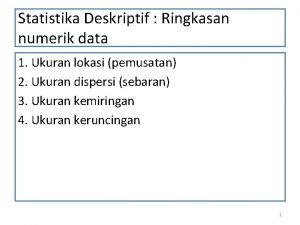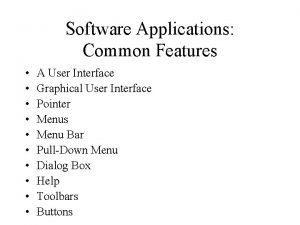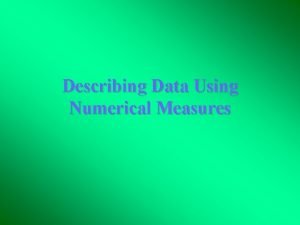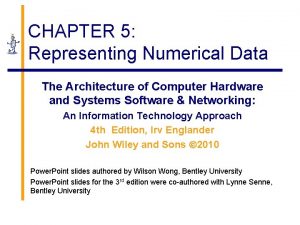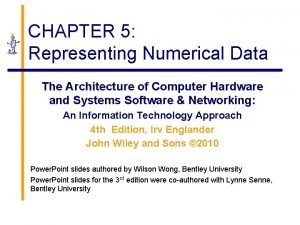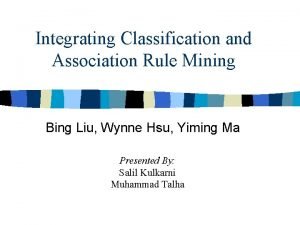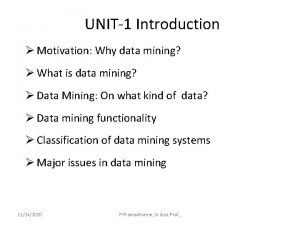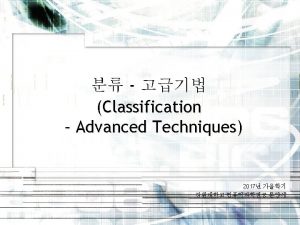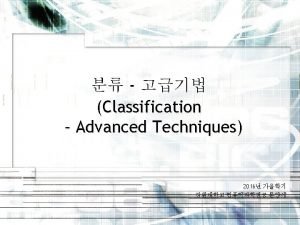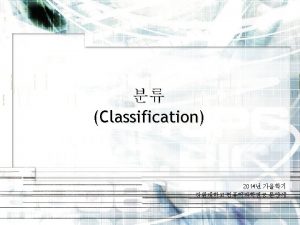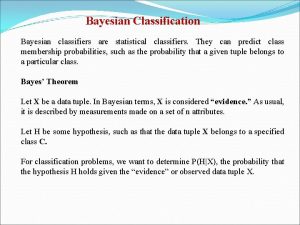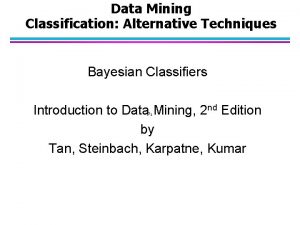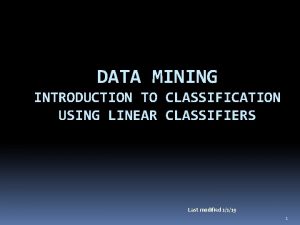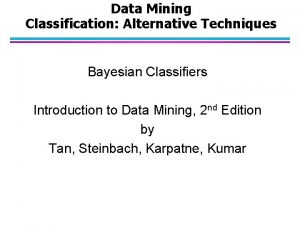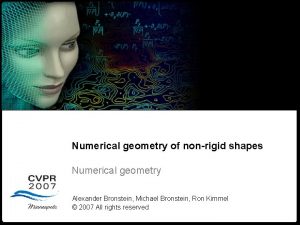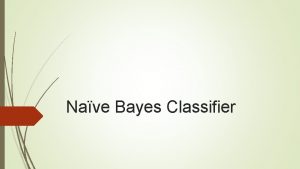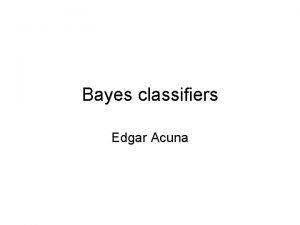Classification Numerical classifiers Introduction to Data mining PangNing




















![Derive (From Machine Learning[6]) • • For two cases • 20 Derive (From Machine Learning[6]) • • For two cases • 20](https://slidetodoc.com/presentation_image_h2/6f61d8df2d71e05147e31ad195a9a2ac/image-21.jpg)
![Output Unit(1) (From Machine Learning[6]) • There is no direct relationship Between Ed and Output Unit(1) (From Machine Learning[6]) • There is no direct relationship Between Ed and](https://slidetodoc.com/presentation_image_h2/6f61d8df2d71e05147e31ad195a9a2ac/image-22.jpg)
![Output Unit(2) (From Machine Learning[6]) • • • 22 Output Unit(2) (From Machine Learning[6]) • • • 22](https://slidetodoc.com/presentation_image_h2/6f61d8df2d71e05147e31ad195a9a2ac/image-23.jpg)







































![Reference Basic idea of SVM (1) [1] A Training Algorithm for Optimal Margin Classifiers Reference Basic idea of SVM (1) [1] A Training Algorithm for Optimal Margin Classifiers](https://slidetodoc.com/presentation_image_h2/6f61d8df2d71e05147e31ad195a9a2ac/image-63.jpg)
![Reference Basic idea of SVM (2) [4] An Introduction to Kernel-Based Learning Algorithms K. Reference Basic idea of SVM (2) [4] An Introduction to Kernel-Based Learning Algorithms K.](https://slidetodoc.com/presentation_image_h2/6f61d8df2d71e05147e31ad195a9a2ac/image-64.jpg)
![Reference Web site • [9] LIBSVM Chih-Chung Chang and Chih-Jen Lin http: //www. csie. Reference Web site • [9] LIBSVM Chih-Chung Chang and Chih-Jen Lin http: //www. csie.](https://slidetodoc.com/presentation_image_h2/6f61d8df2d71e05147e31ad195a9a2ac/image-65.jpg)
- Slides: 65

Classification Numerical classifiers Introduction to Data mining Pang-Ning Tan, Michael Steinbach, Vipin Kumar Presented by: Ding-Ying Chiu Date: 2008/10/17 0

Introduction Applications • Applications of classification – handwritten digital detection – human face recognition • Training – Classifier 1

Training data One dimension • Training data – a training datum consists of an input vector and a class label. • Feature – the concept of feature is used to denote a piece of information of the objects. A feature is a dimension. Class label inappropriate 20 Input vector inappropriate 45 inappropriate 60 appropriate 80 85 appropriate 95 appropriate Math 2

Two steps One dimension • Training step – Based on the training data, we can compute a boundary to separate the two classes. • Classifying step – a test datum only has the input vector and will be decided its answer vector by the boundaries. Class label inappropriate 20 Input vector inappropriate 45 inappropriate 60 65 appropriate 80 85 appropriate boundary 95 appropriate Math 3

Preliminary Linear programming • The math course in senior high school (0, 8) X+Y- 8 = 0 If we replace x and y by a vector and the result of the function is zero, then the vector lies in the line. B (6, 7) A (4, 4) C (2, 2) (8, 0) If we replace x and y by a vector and the result of the function is greater than zero, then the vector is above the line. If we replace x and y by a vector and the result of the function is less than zero, then the vector is below the line. 4

Two dimensions Simple case English a 1 X+ a 2 Y + a 3 = 0 100 65, 100 10, 90 80 appropriate 80, 80 inappropriate 60 85, 70 30, 60 50, 60 70, 60 95, 50 60, 45 40 Linear programming 80, 20 20 Math 20 40 60 80 100 5

Two dimensions Complex case a 1 X + a 2 Y + a 3 = 0 b 1 X + b 2 Y + b 3 = 0 c 1 X + c 2 Y + c 3 = 0 X Y a 2 X b 1 Y b 2 X c 1 Y a 3 a 1 c 2 b 3 c 3 6

Two dimensions X Y a 1 b 1 Y b 2 X c 1 Y c 2 X b 3 Perceptron b 1 b 3 a 2 b 2 c 3 Neural networks a 1 a 2 X a 3 Y c 2 Input layer c 1 c 3 Hidden layer Output layer Page: 247 250 Page: 251 7

Preliminary Dot product x 1 a 1 X + a 2 Y + a 3 = 0 a 3 X a 1 Y a 2 x 2 w 2 . . . xd w 1 X 0=1 w 0 wd wdxd+wd-1 xd-1+…+w 1 x 1+w 0 x 0 Page: 248 – 5. 23 (wd, wd-1, …, w 1, w 0) (xd, xd-1, …, x 1, x 0) = W X 8

Learning the ANN Model Error function Page: 247 x 2 10 N x 1 x 2 y 1 3 9 1 2 7 8 1 3 9 5 1 4 2 6 -1 5 4 2 -1 6 7 3 -1 y=1 (3, 9) (7, 8) 5 (2, 6) Error function (Page: 253 – 5. 25) (9, 5) y=-1 (7, 3) 9 x 1+13 x 2– 117=0 (4, 2) 5 10 w 1=9, w 2=13, w 0=-117 x 1 9

Learning the ANN Model Bad line x 2 11 x 1+2 x 2 -66=0 10 y 1 3 9 1 2 7 8 1 3 9 5 1 4 2 6 -1 5 4 2 -1 6 7 3 -1 y=1 (3, 9) Error function (Page: 253 – 5. 25) (7, 8) 5 N x 1 x 2 (2, 6) (9, 5) y=-1 E(w)=0. 5*{(1 -(-1))2+(1 -1)2+(-1 -1)2} = 4 (7, 3) (4, 2) 5 10 x 1 10

Learning the ANN Model Goal • Page 253: – The goal of the ANN learning algorithm is to determine a set of weights w that minimize the total sum of squared errors: x 2 • A trick for finding minimum value – Gradient descent method 10 (3, 9) 5 (7, 8) (2, 6) (9, 5) (4, 2) 5 (7, 3) 10 x 1 11

Gradient descent method Main idea f(x) random f(x+ x) x Start with a point (random) Repeat Determine a descent direction Choose a step (λ> 0) Update Until stopping criterion is satisfied • Taylor theorem (new)x’=(old)x’+ x x’ • A trick for finding minimum value + + 12

Gradient descent method Main idea f(x) f(x+ x) x Start with a point (random) Repeat Determine a descent direction Choose a step (λ> 0) Update Until stopping criterion is satisfied • Taylor theorem • A trick for finding minimum value + + 13

Gradient descent method Example f(x)=(x+1)2+2 λ = 0. 25 f’(x)=2(x+1) 15 x=3, x = -0. 25*8 = -2 10 5 x (new)x’=3 -2=1 3 14

Gradient descent method Example f(x)=(x+1)2+2 λ = 0. 25 15 f’(x)=2(x+1) x=3, x = -0. 25*8 = -2 10 x=1, x = -0. 25*4 = -1 5 -0. 50 1 x=0, x = -0. 25*2 = -0. 5 15

Gradient descent method Two dimensions (from MATLAB demo) 16

Gradient descent method Error function • Minimum target : • Adjust value : f(x) • random f(x+ x) Page: 254 – 5. 26 x (new)x’ x’ =(old)x’+ x 17

Sigmoid function 1 117 -1 18

Sigmoid function Nice property 19
![Derive From Machine Learning6 For two cases 20 Derive (From Machine Learning[6]) • • For two cases • 20](https://slidetodoc.com/presentation_image_h2/6f61d8df2d71e05147e31ad195a9a2ac/image-21.jpg)
Derive (From Machine Learning[6]) • • For two cases • 20
![Output Unit1 From Machine Learning6 There is no direct relationship Between Ed and Output Unit(1) (From Machine Learning[6]) • There is no direct relationship Between Ed and](https://slidetodoc.com/presentation_image_h2/6f61d8df2d71e05147e31ad195a9a2ac/image-22.jpg)
Output Unit(1) (From Machine Learning[6]) • There is no direct relationship Between Ed and netj • 21
![Output Unit2 From Machine Learning6 22 Output Unit(2) (From Machine Learning[6]) • • • 22](https://slidetodoc.com/presentation_image_h2/6f61d8df2d71e05147e31ad195a9a2ac/image-23.jpg)
Output Unit(2) (From Machine Learning[6]) • • • 22

Learning the ANN Model Adjust x 2 11 x 1+2 x 2 -66=0 10 y 1 3 9 1 2 7 8 1 3 9 5 1 4 2 6 -1 5 4 2 -1 6 7 3 -1 y=1 (3, 9) Error function (Page: 253 – 5. 25) (7, 8) 5 N x 1 x 2 (2, 6) (9, 5) y=-1 E(w)=0. 5*{(1 -(-1))2+(1 -1)2+(-1 -1)2} = 4 (7, 3) (4, 2) 5 10 x 1 23

The advantages of neural network To approximate any function • Multilayer neural networks with at least one hidden layer are universal approximators; i. e. , they can be used to approximate any target functions. (Page 255) • Feedforward networks containing three layers of units are able to approximate any function to arbitrary accuracy, given a sufficient (potentially very large) number of units in each layer. (From Machine learning[6]. Page 122) 24

The advantages of neural network Handle redundant features • ANN can handle redundant features because the weights are automatically learned during the training step. The weights for redundant features tend to be very small. (Page 256) Height 1*x + 0*y – 60 = 0 • Feature selection 60 Math 25

The disadvantages of neural network Sensitive to the presence of noise • Neural networks are quite sensitive to the presence of noise in the training data. Height 60 Math 26

The disadvantages of neural network Local minimum • The gradient descent method used for learning the weights of an ANN often converges to some local minimum. f(x) x x 27

The disadvantages of neural network Time consuming x 2 • Training an ANN is a time consuming process, especially when the number of hidden nodes is large. 11 x 1+2 x 2 -66=0 10 Y=1 (3, 9) (7, 8) 5 (2, 6) (9, 5) Y=-1 (7, 3) (4, 2) 5 10 x 1 28

Real dataset MNIST 28 28 784 dimensions 29

Feature selection Wavelet transform • A multimedia object can be represented by the lowlevel features – High dimension • Wavelet 30

Introduction 90000 22500 5625 1406 31

Result of wavelet transform 32

Support Vector Machines Which hyperplane? y=1 y=-1 33

Support Vector Machines Margin y=1 d- d- d+ y=-1 Margin = |d+|+|d-| 34

Support Vector Machines Maximum Margin y=1 d+ d- d- y=-1 d+ Support vectors 35

Support Vector Machines Classifier of Two Classes • Training data (x 1, y 1), …, (xn, yn) yi {1, -1} • Find: 10 x 1 x 2 (3, 9) (7, 8) x 4 5 y=1 x 3 (2, 6) (9, 5) y=-1 x 6 x 5 (7, 3) 9 x 1+13 x 2– 117=0 (4, 2) 5 10 36

Support Vector Machines Rescale • We can rescale the parameters w and b of the decision boundary so that the two parallel hyperplanes bi 1 and bi 2 can be expressed as follows: (Page 261 – 5. 32&5. 33) y=1 d+ ddd+ y=-1 bi 2 bi 1 37

Support Vector Machines Margin d y=1 y=-1 d x 2 Page: 261 5. 32 5. 33 5. 34 x 1 -x 2 x 1 bi 2 bi 1 38

Support Vector Machines Objective function y=1 y=-1 d • The learning task in SVM can be formalized as the following constrained optimization problem: Page: 262 Definition 5. 1 39

Lagrange multipliers Problem • Problem – A maximum or minimum function – A constraint • The learning task in SVM can be formalized as the following constrained optimization problem: • Ex: A T-shirt costs Px dollars and a skirt costs Py dollars. Happy function U(X, Y), Income A. Max(U(X, Y)) subject to Px. X+Py. Y A 40

Lagrange multipliers Concept • Ex: A T-shirt costs Px dollars and a skirt costs Py dollars. Happy function U(X, Y), Income A. Max(U(X, Y)) subject to Px. X+Py. Y A If (Px. X+Py. Y-A) > 0, the result is positive. • Lagrange multipliers λ 0 L(X, Y, ) = U(X, Y) - (Px. X+Py. Y-A) • Transforming the constrained maximization problem to an unconstrained maximization problem. 41

Lagrange multipliers Example • U(X, Y)=XY and Px = 2, Py = 4 , I = 40 Max. L(X, Y, ) =XY - (2 X+4 Y-40) L/ X = Y-2 = 0 ……………(1) L/ Y = X-4 = 0 ……………(2) L/ = 40 – 2 X – 4 Y = 0. …(3) by (1) and (2) x = 2 y ……. (4) by (3) and (4) 40 – 8 y = 0 y = 5 , x = 10 =2. 5 Problem: A maximum or minimum function A constraint Lagrange Multipliers: Transforming the constrained maximization problem to an unconstrained maximization problem 42

Support Vector Machines Lagrange multipliers • Constrained optimization problem If (yi(w xi+b)<1), the result is negative. • Lagrange Multipliers: Page: 262 5. 39 5. 40 Don’t forget it 43

Support Vector Machines Non-separable Case – simple case Non-linear mapping function (x) = x 2 -2 -1 0 1 2 3 44

Support Vector Machines Non-separable Case Non-linear mapping function (X) (X) (X) (O) (X) (O) (O) (O) 45

Support Vector Machines Observation Non-linear mapping function Page: 273 5. 59 (X) (X) (X) (O) (X) (O) (O) (O) 46

Support Vector Machines Kernel Trick Page: 273 • We do not have to know the exact form of the mapping function because the kernel functions used in nonlinear SVM must satisfy a mathematical principle known as Mercer’s theorem. (Theorem 5. 1) (X) (X) (X) (O) (X) (O) (O) (O) • This principle ensures that the kernel functions can always be expressed as the dot product between two input vectors in some high-dimensional space. 47

Kernel Trick Example R 2 R 3 We don’t have to know the mapping function 48

Support Vector Machines Kernel Trick (X) (X) (X) (O) (X) (O) (O) (O) Page: 275 5. 63 5. 64 5. 65 Polynomial Gaussian Sigmoidal 49

Support Vector Machines Result 50

The advantages of SVM The global minimum • The SVM learning problem can be formulated as a convex optimization problem, in which efficient algorithms are available to find the global minimum of the objective function. 51

Support Vector Machines Kernel matrix Page: 264 For larger data sets, the dual optimization problem can be solved using numerical techniques such as quadratic programming, …. Page: 263 5. 43 Original data matrix Kernel function Kernel matrix 52

The disadvantages of SVM 53

The disadvantages of SVM 54

SVM Tools LIBSVM Easy to use Parameter selection 55

LIBSVM Parameter 56

K-nearest neighbors classifier Concept K=2 1 Test datum 57

K-nearest neighbors classifier Bad example K=1 K=3 Test datum K=5 K=7 K=9 K = 11 58

K-nearest neighbors classifier Drawbacks • Choosing the value of k: – If k is too small, sensitive to noise points – If k is too large, neighborhood may include points from other classes Page: 225 Figure 5. 8 X • Classifying test data are relatively expensive – MNIST, 728 dimensions, 60, 000 training data 59

Experiments http: //yann. lecun. com/exdb/mnist/ 60

Experiments (Conti. ) http: //yann. lecun. com/exdb/mnist/ 61
![Reference Basic idea of SVM 1 1 A Training Algorithm for Optimal Margin Classifiers Reference Basic idea of SVM (1) [1] A Training Algorithm for Optimal Margin Classifiers](https://slidetodoc.com/presentation_image_h2/6f61d8df2d71e05147e31ad195a9a2ac/image-63.jpg)
Reference Basic idea of SVM (1) [1] A Training Algorithm for Optimal Margin Classifiers Bernhard E. Boser, Isabelle Guyon, Vladimir Vapnik Proceedings of the Fifth Annual ACM Conference on Computational Learning Theory, 1992, pp. 144 -152. [2] Support-Vector Networks Corinna Cortes, Vladimir Vapnik Machine Learning 20(3), 1995, pp. 273 -297. [3] A Tutorial on Support Vector Machines for Pattern Recognition Christopher J. C. Burges Data Mining and Knowledge Discovery 2(2), 1998, pp. 121 -167. 62
![Reference Basic idea of SVM 2 4 An Introduction to KernelBased Learning Algorithms K Reference Basic idea of SVM (2) [4] An Introduction to Kernel-Based Learning Algorithms K.](https://slidetodoc.com/presentation_image_h2/6f61d8df2d71e05147e31ad195a9a2ac/image-64.jpg)
Reference Basic idea of SVM (2) [4] An Introduction to Kernel-Based Learning Algorithms K. -R. Müller, S. Mika, G. Rätsch, K. Tsuda, and B. Schölkopf IEEE Transactions on Neural Networks 12(2), 2001, pp 181 -202. [5] A Tutorial on Support Vector Regression A. J. Smola and B. Schölkopf Neuro. COLT Technical Report NC-TR-98 -030, Royal Holloway College, University of London, UK, 1998. [6] Machine Learning Tom M. MITCHELL Mc. GRAW-HILL International editions 63
![Reference Web site 9 LIBSVM ChihChung Chang and ChihJen Lin http www csie Reference Web site • [9] LIBSVM Chih-Chung Chang and Chih-Jen Lin http: //www. csie.](https://slidetodoc.com/presentation_image_h2/6f61d8df2d71e05147e31ad195a9a2ac/image-65.jpg)
Reference Web site • [9] LIBSVM Chih-Chung Chang and Chih-Jen Lin http: //www. csie. ntu. edu. tw/~cjlin/libsvm/ • [10] Convex Optimization with Engineering Applications Professor Stephen Boyd, Stanford University http: //www. stanford. edu/class/ee 364/ • [11] Advanced Topics in Learning & Decision Making Professor Michael I. Jordan, University of California at Berkeley http: //www. cs. berkeley. edu/~jordan/ 64
 Mining complex types of data
Mining complex types of data Multimedia data mining
Multimedia data mining Introduction to data mining and data warehousing
Introduction to data mining and data warehousing Primary and secondary keywords
Primary and secondary keywords Helmert contrast
Helmert contrast Asl classifiers worksheet
Asl classifiers worksheet Asl classifiers worksheet
Asl classifiers worksheet What are classifiers in asl
What are classifiers in asl Asl classifiers worksheet
Asl classifiers worksheet Chinese classifiers
Chinese classifiers Asl classifiers examples
Asl classifiers examples Bill vicars lesson 1
Bill vicars lesson 1 Lifeprint classifiers
Lifeprint classifiers Linear classifiers
Linear classifiers Asl classifiers examples
Asl classifiers examples Linear classifiers
Linear classifiers Linear classifiers
Linear classifiers Non linear classifiers
Non linear classifiers Lifeprint classifiers
Lifeprint classifiers Instrumental classifiers asl
Instrumental classifiers asl Bayesian classification in data mining lecture notes
Bayesian classification in data mining lecture notes Classification and clustering in data mining
Classification and clustering in data mining Basic concepts of classification in data mining
Basic concepts of classification in data mining Classification alternative techniques in data mining
Classification alternative techniques in data mining Strip mining vs open pit mining
Strip mining vs open pit mining Chapter 13 mineral resources and mining worksheet answers
Chapter 13 mineral resources and mining worksheet answers Difference between strip mining and open pit mining
Difference between strip mining and open pit mining Web text mining
Web text mining Introduction to data mining and knowledge discovery
Introduction to data mining and knowledge discovery Complex data types in data mining
Complex data types in data mining Data mining azure
Data mining azure Data reduction in data mining
Data reduction in data mining Data mining in data warehouse
Data mining in data warehouse What is missing data in data mining
What is missing data in data mining Data reduction in data mining
Data reduction in data mining Data reduction in data mining
Data reduction in data mining Data reduction in data mining
Data reduction in data mining Shell cube in data mining
Shell cube in data mining Data reduction in data mining
Data reduction in data mining Perbedaan data warehouse dan data mining
Perbedaan data warehouse dan data mining Perbedaan data warehouse dan data mining
Perbedaan data warehouse dan data mining Data warehousing and data mining in crm
Data warehousing and data mining in crm Descriptive mining of complex data objects
Descriptive mining of complex data objects Data warehousing data mining and olap
Data warehousing data mining and olap Noisy data in data mining
Noisy data in data mining 3-tier data warehouse architecture
3-tier data warehouse architecture Data preparation for data mining
Data preparation for data mining Data compression in data mining
Data compression in data mining Data warehouse dan data mining
Data warehouse dan data mining Hiral panchal
Hiral panchal C programming and numerical analysis an introduction
C programming and numerical analysis an introduction Counterdiscipline
Counterdiscipline Programs that organize analyze and graph numerical data
Programs that organize analyze and graph numerical data Numerical measure of how alike two data objects are
Numerical measure of how alike two data objects are Which is the example of grouped data
Which is the example of grouped data Numerical methods for describing data
Numerical methods for describing data Numerical summary of data
Numerical summary of data Asu
Asu Programs that organize analyze and graph numerical data
Programs that organize analyze and graph numerical data Describing data with numerical measures
Describing data with numerical measures Representing numerical data
Representing numerical data Representing numerical data
Representing numerical data Integrating classification and association rule mining
Integrating classification and association rule mining Unsupervised learning in data mining
Unsupervised learning in data mining Motivation for data mining
Motivation for data mining Data mining concepts and techniques slides
Data mining concepts and techniques slides



